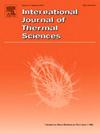Inversion of complex refractive index of natural kapok fibers based on BRDF scattering experiments and FDTD-QPSO method
IF 4.9
2区 工程技术
Q1 ENGINEERING, MECHANICAL
International Journal of Thermal Sciences
Pub Date : 2025-05-17
DOI:10.1016/j.ijthermalsci.2025.110010
引用次数: 0
Abstract
The systematic research and development of fiber materials in the field of radiative regulation depends on the complex refractive index of the base material. However, there are some problems in the complex refractive index measurement of fiber materials based on ellipsometry, which makes the complex refractive index difficult to obtain and the measurement results may be problematic. Based on the first-principles calculations of electromagnetic scattering, an FDTD-QPSO method is proposed to invert the complex refractive index of the fiber by using the scattering characteristics. In this paper, the inversion of the complex refractive index of hollow fiber is studied and the appropriate inversion error interval is given. The results show that the method has good convergence effect and accuracy in the inversion calculation. Finally, the complex refractive index of natural kapok fiber is retrieved, and the inversion results are analyzed by combining K-K relations and the visible light color of actual kapok fiber. This work improves the complex refractive index inversion model of fiber materials and provides a certain numerical basis for studying the complex refractive index or radiative regulation mechanism of fiber materials.
基于BRDF散射实验和FDTD-QPSO方法的天然木棉复折射率反演
光纤材料在辐射调节领域的系统研究和发展依赖于基材的复折射率。然而,基于椭圆偏振法测量光纤材料的复折射率存在一些问题,使得复折射率难以获得,测量结果可能存在问题。在电磁散射第一性原理计算的基础上,提出了利用光纤散射特性反演光纤复折射率的FDTD-QPSO方法。本文研究了中空光纤复折射率的反演问题,并给出了适当的反演误差区间。结果表明,该方法具有较好的收敛效果和反演计算精度。最后,提取天然木棉纤维的复折射率,结合K-K关系和实际木棉纤维的可见光颜色,对反演结果进行分析。本工作完善了纤维材料的复折射率反演模型,为研究纤维材料的复折射率或辐射调节机理提供了一定的数值依据。
本文章由计算机程序翻译,如有差异,请以英文原文为准。
求助全文
约1分钟内获得全文
求助全文
来源期刊

International Journal of Thermal Sciences
工程技术-工程:机械
CiteScore
8.10
自引率
11.10%
发文量
531
审稿时长
55 days
期刊介绍:
The International Journal of Thermal Sciences is a journal devoted to the publication of fundamental studies on the physics of transfer processes in general, with an emphasis on thermal aspects and also applied research on various processes, energy systems and the environment. Articles are published in English and French, and are subject to peer review.
The fundamental subjects considered within the scope of the journal are:
* Heat and relevant mass transfer at all scales (nano, micro and macro) and in all types of material (heterogeneous, composites, biological,...) and fluid flow
* Forced, natural or mixed convection in reactive or non-reactive media
* Single or multi–phase fluid flow with or without phase change
* Near–and far–field radiative heat transfer
* Combined modes of heat transfer in complex systems (for example, plasmas, biological, geological,...)
* Multiscale modelling
The applied research topics include:
* Heat exchangers, heat pipes, cooling processes
* Transport phenomena taking place in industrial processes (chemical, food and agricultural, metallurgical, space and aeronautical, automobile industries)
* Nano–and micro–technology for energy, space, biosystems and devices
* Heat transport analysis in advanced systems
* Impact of energy–related processes on environment, and emerging energy systems
The study of thermophysical properties of materials and fluids, thermal measurement techniques, inverse methods, and the developments of experimental methods are within the scope of the International Journal of Thermal Sciences which also covers the modelling, and numerical methods applied to thermal transfer.
 求助内容:
求助内容: 应助结果提醒方式:
应助结果提醒方式:


